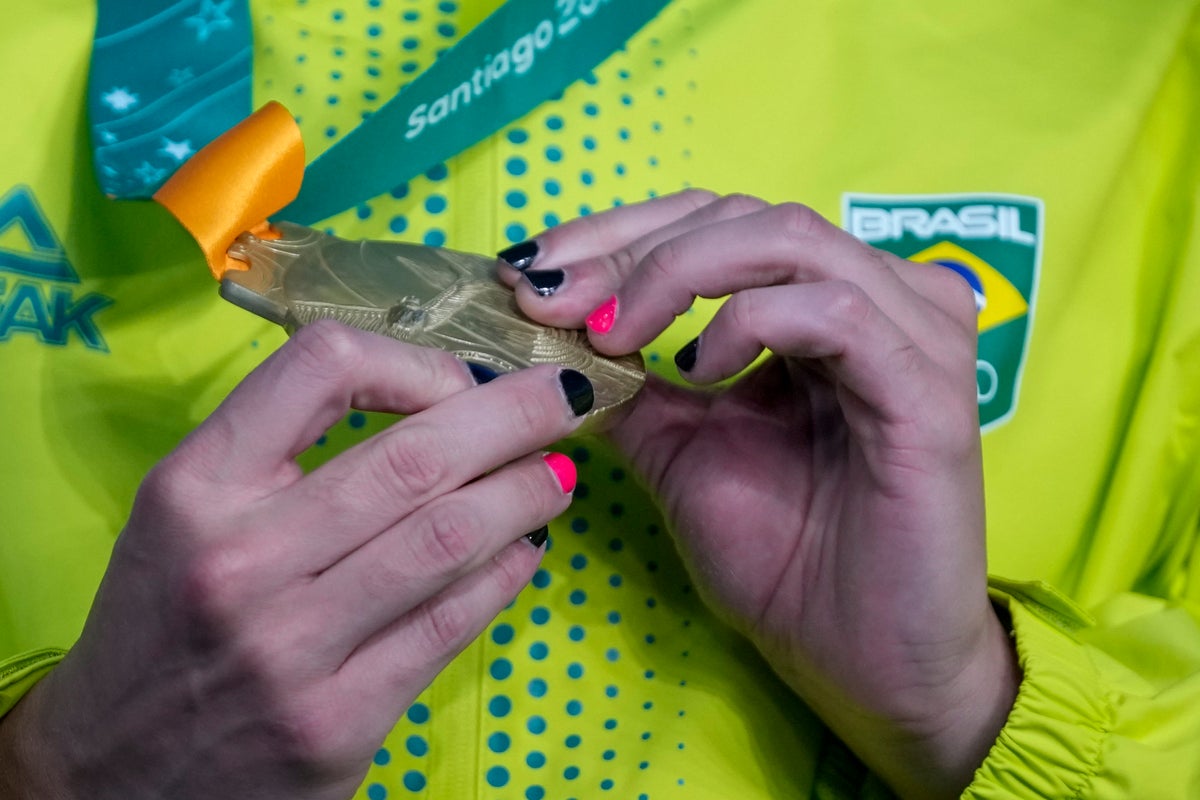
Every stroke of swimmer Felipe Ribeiro in the pool at the Pan American Games reminded the Brazilian of the bipolar disorder he dealt with ahead of competing in Chile.
The nails of the 25-year-old are painted black, except for his pink-colored ring fingers.
Mental health and how athletes deal with it have become top of mind for athletes, coaches and sports executives alike, even more so since the Tokyo Olympics in 2021 when American superstar gymnast Simone Biles skipped several title defenses in an attempt to protect herself.
A talking point at the athletes’ village, Ribeiro’s painted nails have invited some of his competitors and teammates to hear about his story. Only months ago, that included thoughts of self-harm, sleep deprivation and impulsiveness. Still, he won three gold medals at the largest multi-sport event on the continent, all in relays: 4 x 100 meters freestyle, 4 x 200 freestyle and mixed 4 x 100 freestyle.
“I went through a tough time in the beginning of this year, the end of last year. I had anxiety, panic attacks,” Ribeiro told The Associated Press on the sideline of the swimming competitions in Santiago. “Until recently, I couldn’t control my head. It had its own life. I only slept when I was totally exhausted, had to play guitar in the middle of the night.”
Ribeiro left his training in Florida in 2019 to move back with his family in Brazil, often unable to practice because he says he felt like he was not mentally fit. He called his coach during training hours so he could listen to other swimmers at work, hoping that would give him a boost. That was rarely the case.
The Brazilian says he was diagnosed last year with bipolar disorder, a mental illness that can cause shifts in mood, energy and activity levels, among other symptoms. He said his treatment has been based on a change of medication — which was previously for depression — and regular consultations with a psychiatrist, which allowed him to gradually return to training in March and competition in April.
“The treatment for bipolar disorder is a combination between psychological therapy and medicine. It doesn't work without the coordination between the psychologist and the psychiatrist,” said sports psychologist Eduardo Cillo, a staffer of Brazil's Olympic committee at the Pan American Games. “The chance of a relapse is enormous if only one part of the treatment is performed. Also, the family of the patient needs to be involved, so there is a network of care going beyond the doctors' offices.”
One strategy that Ribeiro adopted, he has kept.
“I started painting my left-hand nails black. Then both hands. And then I started getting tired of wearing the same color,” Ribeiro said, who announced his condition earlier this year to website UOL. “Now people come to me and ask what the nails are about. They come at dinner, lunch time at the athletes’ village. I don’t know if any of them have a condition, too. But it is good to speak about it, raise awareness.”
Today, the U.S. Olympic and Paralympic Committee (USOPC) have 13 practitioners working full time. Most of U.S. competitors at the Pan American Games in Santiago also have available psychologists or counselors, who pick up signals that could be key in helping them ahead of the Paris Olympics next summer.
Angel Brutus, a licensed counselor working at the USOPC, said mental health professionals have worked to detect early signals and symptoms such as Ribeiro’s and point athletes toward help. She couldn't specifically discuss cases but says she and her colleagues are not only active listeners, but also “elite noticers."
“One is the sense of belonging or a thwarted sense of belonging, meaning that they don’t feel like they belong anywhere,” Brutus said. “The other is the capacity for increased distress, tolerance. The third one is that sense of burdensome, when they see their problems hits others.”
Cillo said there’s a tough balance to strike between athletes’ wellness and helping them achieve their best performances.
“Some psychiatric disorders are momentary, others are chronic. And the same goes for anxiety and depression peaks, mood oscillation. We pay most attention to three gauges; excess, deficit and constant oscillation,” Cillo said. “Only when you secure mental health, you move on to improve the performances.”
Greater awareness and openness around mental illness can help increase support from others in the community, especially when people are dealing with issues such as disappointment, loss or pressure.
Ribeiro says he'll continue to express whenever he feels when his mental health is at risk.
“It is what can take me out of the pool, of my social environment, out of everything,” he said. “But I won’t let that happen again. I can find help with the tip of my fingers.”







